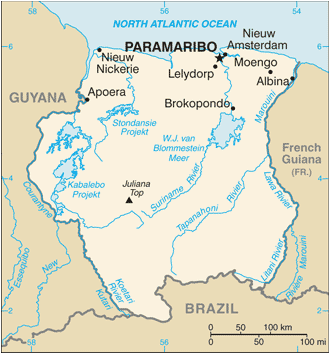
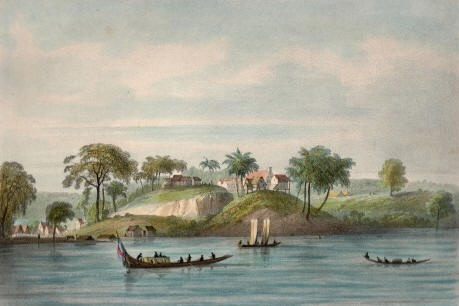
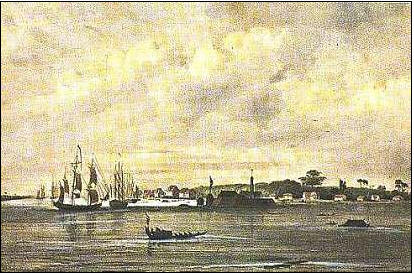
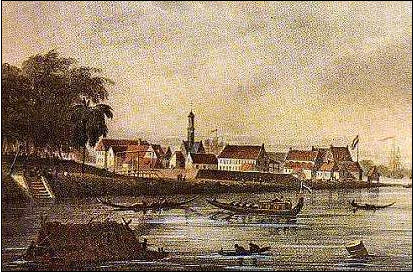
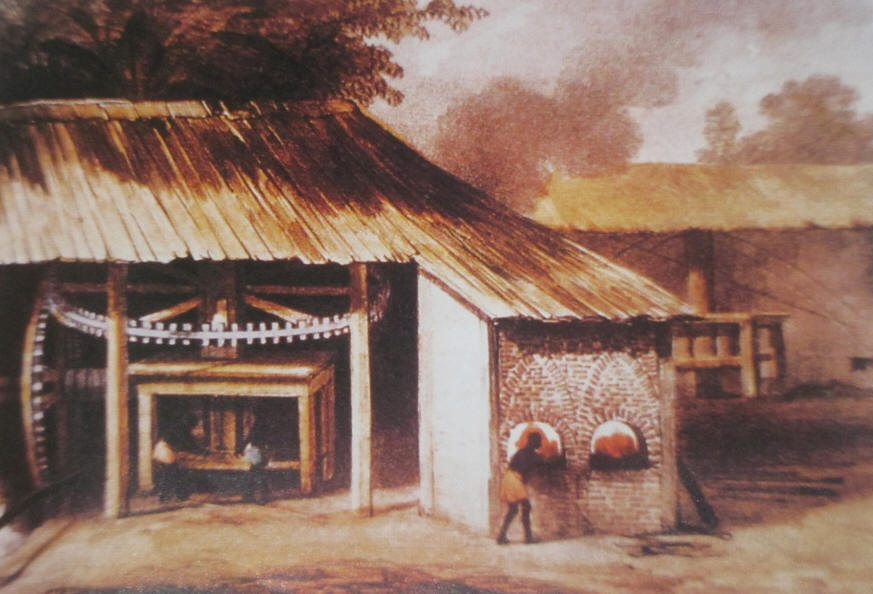
This is the 1st of 4 images of life in Surinam we have selected from the paintings of Pierre Jacques Benoit.
 |
 |
 |
 |
 |
||
| Surinam - between the mouths of the Orinoco and Amazon rivers |
Jodensavanne - on the
Surinam River 50km south of Paramaribo. This is the 1st of 4 images of life in Surinam we have selected from the paintings of Pierre Jacques Benoit. |
Paramaribo the capital of Surinam. Painted by Pierre Jacques Benoit who made several trips to Surinam around the end of the 18th century. | Fort Zeelandia near modern Paramaribo was named by Dutch Admiral Abraham Crijnssen after he took it from the English on 25 Feb 1667. The English named it Fort Willoughby after they captured the small timber fort built here by the French in 1640. | Cane crusher |
The loss of Dutch Brazil created a need for new Dutch sugar-growing regions. Many of the displaced Jewish planters from Brazil went to Amsterdam in the first instance but some went elsewhere (see note 9 below). The Dutch Provinces and of course the Amsterdam Sephardic Jews shared the appetite for colonisation which for some of the Jews had religious connotations (for the Messiah would only come once Jews were scattered everywhere!). The resulting efforts, whilst of course including Jews from Dutch Brazil, also included Jews from elsewhere especially Livorno (see note 1 below). Many of the Jews who went to Dutch Cayenne, Pomeroon or Tobago ended up, through English attacks, in Surinam (see note 7 below). The English granted extensive privileges to them - the first time the English had granted full rights to Jews and it probably reflected what they had learned in Livorno of how the Dutch were recruiting Jews (ref 21 p73). But these English efforts were in vain - for the Dutch gained Surinam on 21 Jul 1667 under the Treaty of Breda. Then the English took Cayenne, and retook Surinam, but upon learning of the Treaty of Breda (in Barbados on 10 Nov 1667) they then had to give it back. The Dutch were in possession by mid-1668 and English efforts then focussed on evacuating English settlers and extracting as many Jews as possible from Surinam.
Up to 200 Jews (see note 4 below) were in Surinam when the Dutch took over and despite the efforts of the English it seems that most stayed on though some specific exceptions can be found (see note 2 below). A reluctance to move is understandable as many of them would have had an exhausting passage to Surinam after the English disruptions, and Dutch toleration of Jews was of longer standing than the English. Nevertheless, the Dutch did not take the Jewish presence for granted, and for example gave a key defence role to a leading Jew Joseph Nassy (see note 3 below). The early years in Surinam were perhaps not easy. Surinam Jews petitioned the French to return to Cayenne, but the French in 1725 refused the petition (ref 21 p54). We believe that, perhaps reflecting this early difficulty, the first Surinam Baruch Lousadas left for Curacao before 1695. However, the Baruch Lousadas were not long absent, as they arrived from Amsterdam (perhaps via Barbados and Curacao) by 1700 and then from Curacao by 1727 and then again by 1747 from which point they stayed until the 20th century. Surinam ultimately became a successful but unpredictable outcome of all those Dutch/Jewish colonisation efforts which were directed elsewhere in the first instance!
We could not find the Baruch Louzada name in Dutch Brazil but it is very prominent in Surinam as 38 Baruch Louzada graves have been found in Surinam (see note 6 below). The first Baruch Lousada was Moses (see note 8 below) who appears in a 1671 list of 58 Jewish males attending the consecration of the Cassipora Synagogue but interestingly not on a 1695 list. Drawing upon the contribution of Fenneke Louzada-Scheltens (see note 5 below) we have been able to suggest how the Baruch Louzadas of Surinam might be linked to the Baruh Lousadas of Barbados and England via Curacao. David Cohen Nassy was a leader of the colonisation efforts which eventuated in Jews coming to Surinam (see note 3) and Fenneke's work shows the descent of her husband Emile Louzada from him via Joseph Nassy. One of the Surinam Baruch Louzadas figures prominently in the informative general article provided by Fenneke - the cantor and community leader David Baruch Louzada (#344 in the Old Sephardi Cemetery of Paramaribo ref 125).
Notes:
1. Some of the graves which were found at Jodensavanne in Surinam were of Livorno Jews (ref 21). Livorno Jews came via a number of Dutch expeditions.
2. We note that Gabriel Antunes went to Barbados in 1675 ref 5 p17 (also ref 21 p196), and Aaron da Silva was in Barbados in 1661; these 2 are included in the list of 10 families of Jews recorded as wanting to leave Surinam after 1667 (in ref 119 p41). Antunes had married the sister Esther of Luis Dias Gutteres who had been endenized in Barbados on 2 Aug 1661 (ref 21 p196) as had Aaron da Silva (ref 42). Gutteres had owned the Quomoka plantation in Surinam in 1673 but he was a long-term resident of Barbados and died there in 1698 (ref 5 p16). Aaron Navarro also moved from Surinam to Barbados and had been in Brazil - when he died in 1685 he still had 10000lb of muscovedo sugar in Surinam in the custody of the Mahamad (and ref 5 p41 notes his family was close in Brazil to the Mercados and the Valverdes). Further Barbados connections and possible moves from Surinam are shown in the case of David Baruch Lousada #612 1677-1741 of Barbados. He had a presence in Surinam, for upon his death he left assets in Surinam for the 'church wardens' to manage (see 1738 deed); ref 194 shows in the year 1705 a wife Rebecca Lopes Mirandella who was probably of a Surinam family, for Isaac Lopes Mirandella appears on the 1695 list. Also in the list of 10 were two families headed by Isaac de Meza and Moses Baruch, both of whom had in 1665 travelled from Rotterdam and sought permission to settle in Surinam when they passed by London. Isaac de Meza was certainly in Barbados (ref 5 p44) though ref 125 also shows many Mezas were in Surinam. The Moses Baruch is not listed as Baruch Louzada so is probably not especially relevant to us, but people with names suggestive of him appeared in Jamaica - Isaac Moses Barak in the 1692 earthquake petition, and Moses Barrow endenized in 1699 or 1700. And ref 119 p41 records 2 probable Jews leaving (Isaac de la Parr and Gabriel de Solis) with the English. Ref 191 p19 shows a David Lopes formerly a planter in Surinam left his Jamaican assets to his brother Moses. We are not certain that everyone on the list of 10 left Surinam, but most did. In any case, movement of Jews and Jewish business connections between Barbados and Surinam existed both before 1667, and survived for a generation or so after Surinam became Dutch.
3. David Cohen Nassy must have left Dutch Brazil before its final loss in 1654 for he was considered in 1652 for colonisation of Curacao, but then actually took part in the colonisation of Pomeroon and Cayenne - from where he reached Surinam. He was also a chief confidant of David Abravanel who led the English resettlement of Jews (see ref 123 p411). Mordecai Arbell (ref 21) discusses 2 other Surinam Nassys. Probably they were sons of David Cohen Nassy. One was Captain Samuel Nassy who played a prominent role in the establishment of a secure Dutch colony in Surinam, by amongst other things quelling rebellion amongst the soldiers in 1688 and beating off a French attack in 1689. Later from Amsterdam he remained involved in the government of the colony and with Baron de Belmonte secured the replacement of the Governor - the same one whom he had left Surinam to avoid (ref 21). The other was Joseph Nassy, made a regional Commander by the Dutch as a means of winning allegiance of the sought-after Jews who had remained in Surinam after the British-Dutch conflict. He was the ancestor of Emile Louzada. Both (probable) sons appear in both the 1671 list and the 1695 list. David Cohen Nassy first joined the Amsterdam Jewish community in 1644.
4. The estimate is by Rens in ref 119 and squares nicely with the 58 Jews in the 1671 list which presumably covers male heads of households. The 1695 list shows an increase to 67 though there are a few females in the later list and Moses Baruch Louzada was absent - having as we suggest departed for Curacao.
5. Great assistance was provided by Fenneke Louzada-Scheltens - in the form of an informative general article on the Jewish history of Surinam, a genealogy of the Baruch Louzadas of Surinam (ref 287), ref 119 which contains a most useful critical analysis of the number of Jews entering and leaving Surinam, an account of the descendants of David Baruch Louzada #44, and a descent of Emile Louzada from David Cohen Nassy. Details of the Louzadas of Surinam in our main genealogy largely derive from her, but also include gravestone data from ref 125 and other details from ref 131 and our suggestion as to how the Surinam Baruch Louzadas relate to the English Baruh Lousadas via Curacao and Livorno. We suggest that not only was David Baruch Lousada #44 linked to the early Baruch Lousada presence in Surinam, first via his brother Moses #1585 (see note 8) and then his oldest son Isaac, but he was the main ancestor of the enduring Baruch Lousadas of Surinam via his great-grandson Isaac #1568.
6. The number 38 is undoubtedly a sizeable underestimate of the family number for it is but a fraction of those in Fenneke's genealogy of the Baruch Louzadas of Surinam. Many graves were discovered in the work leading to ref 125 but many had disappeared. In ref 125 can be found 27 Baruch Lousada graves at the Old Sephardi Cemetery at Paramaribo and 11 at Jodensavanne Cemetery. Due to a custom evident among a few of the Jews of Surinam of using the full grandparent's name for the first four offspring one Baruch Lousada offspring appears under the name of his maternal grandfather Samuel Robles de Medina (#25 in Jodensavanne Cemetery ref 125). All but 2 of the 38 records were readily inserted into Fenneke's genealogy of the Baruch Louzadas of Surinam, there being insufficient data to make anything but a guess at the location of the 2 unplaced records. These were an H H Baruch Lousada son of C Baruch Lousada who died in Dec 1831 (#24 in Jodensavanne Cemetery ref 125), and J B Louzada who died 3 April 1873 aged 74 years and 6 months leaving a widow Rachel (she was #270 of the Old Sephardi Cemetery of Paramaribo in ref 125). Of those 36 graves which were readily fitted, there was reasonable concordance of detailed information, though there were a number of minor discrepancies which can be observed in our modification of Fenneke's genealogy and in our main genealogy. Some of these discrepancies are no doubt due to the difficulties in transcribing eroded gravestones. However other discrepancies may be embodied in Fenneke's genealogy whose sources are not revealed and which we therefore have not reviewed in detail.
7. There was a massive and disruptive English effort to develop Surinam - which they called Willoughby Land - by redirecting to it Jews familiar with sugar. They did this with the Jews of Pomeroon and also with some of the Jews of Cayenne (ie those remaining there after the French seized Cayenne in 1664 and removed some of the Cayenne Jews to Surinam) which they took in 1667. The Dutch reclaimed Pomeroon in 1666, though they later let it languish, and it was destroyed in 1689 by French privateers; eventually it became (with the neighbouring Dutch settlements of New Zeeland and Essequibo) British again and then the Republic of Guyana.
8. He was possibly too young to have come to English Surinam before 1667 (via one or more of Pomeroon, Tobago or Cayenne). It is more likely that he came to Dutch Surinam (ie after 1667 but before 1671) from Amsterdam via Barbados, for Isaac #42 appeared in Amsterdam from Livorno in 1662 when Moses was about 12, and we elsewhere suggest that Isaac was his father.
9. One party arrived in New York (then New Amsterdam) much to the chagrin of its governor Pieter Stuyvessant (ref 49).